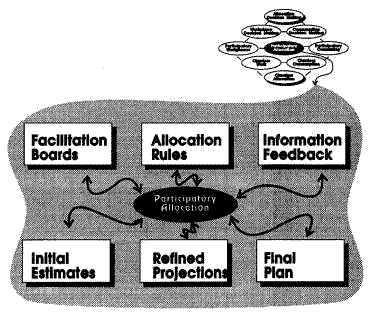|
Looking Forward. By Michael Albert and Robin Hahnel
6. Participatory Allocation |
|
|
There are currently in the
U.S. just under 300,000 finance and insurance establishments, including
banks, credit agencies, commodity brokers, insurance carriers, and just over
200,000 real estate offices. Together these employ nearly 6.4 million people.
To get a feeling for what the transfer of all this to more socially useful
purposes would allow in terms of units per population and region, consider
that in the U.S. there are only 187,430 food stores, 362,895 eating and
drinking places, and 201,631 automotive service stores and service stations,
altogether employing 10.5 million people. These numbers indicate the relative
size of market paraphernalia.
|
So what do we now have? Is the feasible plan that a participatory economy will converge to efficient and equitable? Or will all the bargaining yield an outcome no better than those that result from central planning or markets?
Our answer to these questions should be obvious from previous comments. The equality, solidarity, diversity, and democracy that participatory planning promotes in place of the exploitation, class division, conformity, and hierarchy that characterize capitalist and coordinator economies more than justify a change to the new system. The fact that participatory planning will also be more efficient than markets or central planning clinches the case. [We refer interested readers to chapter 5 of this book's companion volume, The Political Economy of Participatory Economics (Princeton 199 1), for a rigorous demonstration that this is, indeed, so.] Only fear that participatory planning might involve an intolerable bureaucracy remains a pressing concern, so, to allay this fear, we now present a brief comparison between the institutional and time requirements of our model and nonparticipatory alternatives.
Of course, the main allocation institution in any capitalist society is the market which doesn't directly involve employees of any sort since it is "only" a set of relations and rules applying to the interfaces between economic actors and institutions. However, the market does impose a whole host of implications calling forth particular competitive and accounting behaviors in all institutions. Moreover the market imposes a need for many institutions that would not otherwise exist whether in the presence of private property or not.
For example, having markets, we also have banks which have branches in virtually every community utilizing enough buildings to house most if not all of a participatory economy's production and
Will facilitation boards and job complexes within plants and consumer units use all the material and human resources liberated when the institutional paraphernalia of markets disappear? We seriously doubt that the institutional apparatus of participatory planning compares unfavorably with the institutional apparatus of markets or central planning.
We have now presented a description of the basic structure of participatory economics. To get more of a feel for how the system will actually work, in the following three chapters we present descriptions of the behavior of hypothetical actors developing plans in different contexts. As a conclusion for this chapter, however, we would like to present a final discussion that took place between our usual protagonists shortly after PE described participatory planning, much as you have just read.
|
|
|

